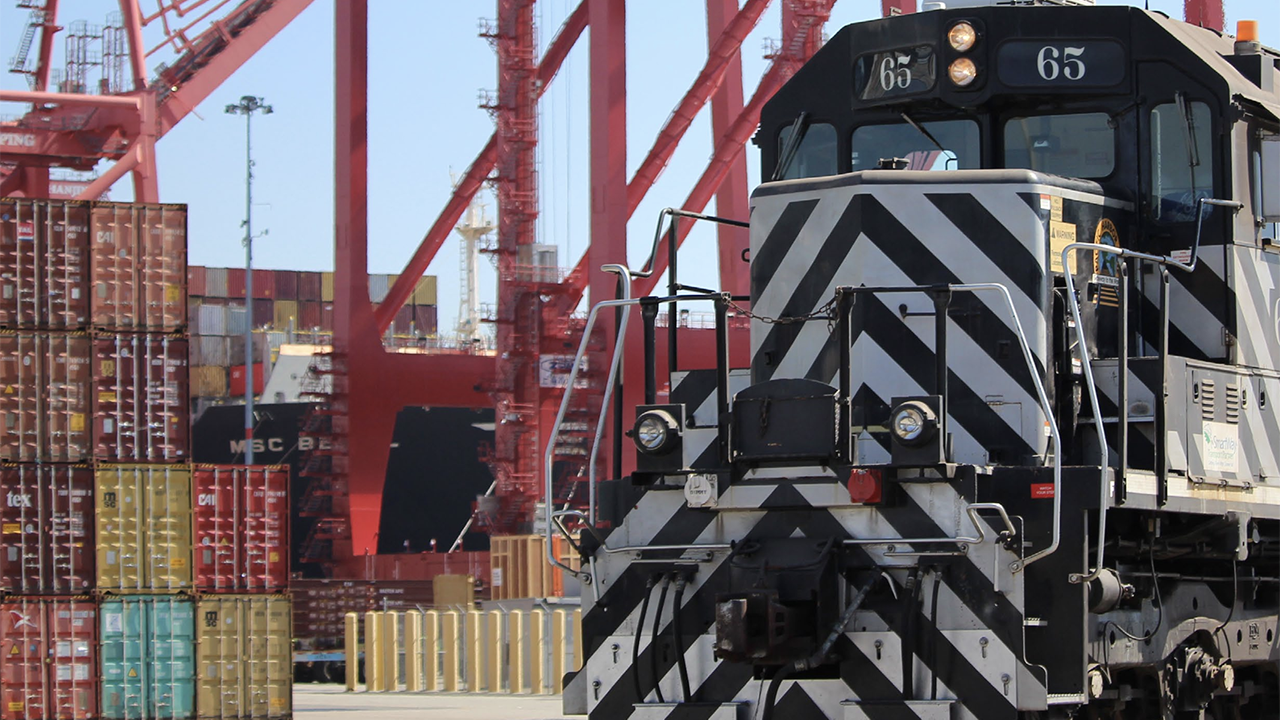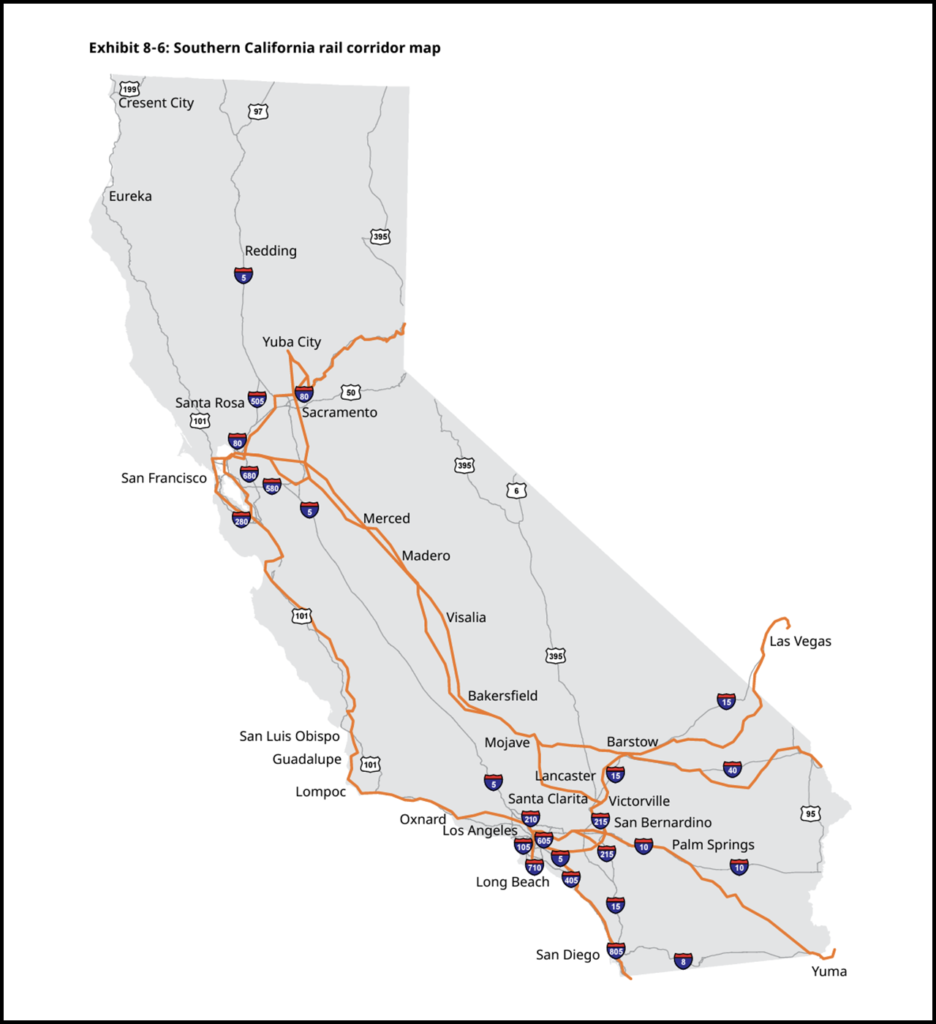
ARH Explores Rail Shuttle-Inland Port Concept
Written by Marybeth Luczak, Executive Editor
(ARH Photograph)
Chicago-based Anacostia Rail Holdings (ARH) on Jan. 31 released two new reports examining the feasibility and benefits of rail service operating to an inland port for intermodal containers destined within 150 miles of the ports of Los Angeles and Long Beach.
The reports estimate that some 3.1 million TEUs (twenty-foot equivalent units)—about a third of imports coming into the ports of Los Angeles and Long Beach—could be addressable by a rail shuttle-inland port in the *Inland Empire, according to ARH, which commissioned the reports by Oliver Wyman, and Leachman & Associates (download below), on behalf of its subsidiary Pacific Harbor Line, the neutral rail-switching operator for the ports of Los Angeles and Long Beach that serves BNSF and Union Pacific (UP). A further opportunity exists for up to 1.5 million TEUs if cross-docks relocate to the vicinity of the inland port, said ARH, noting that at full share shift, this could eliminate some 5,100 short-haul truck moves from the Los Angeles/Long Beach ports every weekday.
“Ports worldwide are looking for ways to improve supply chain capacity and performance, lower shipping costs, and reduce port and local road congestion due to trucks,” ARH said. One potential option, it reported, is to move some of the activities that occur at or near maritime ports (such as intermodal container sorting and delivery) to a truck/rail terminal further inland (an inland port) using a short-haul, on-dock rail service.
“This concept has the potential to offer benefits to the ports and the surrounding community in terms of sustainability, unlocking capacity and reducing congestion,” ARH President Peter Gilbertson said. “Although implementing such a service also has challenges, we felt it was important to consider the parameters under which a transportation alternative like this might be viable.”
“The Port of Long Beach appreciates Pacific Harbor Line’s initiative in exploring outside-the-box solutions that could grow the Port’s market share and address the region’s environmental challenges,” Port of Long Beach Executive Director Mario Cordero said.

ARH pointed out that Class I railroads are planning significant investment in intermodal terminals: BNSF in Southern California at Barstow and Union Pacific (UP) in the Inland Empire. UP has also announced plans for a new international intermodal service from the Los Angeles Basin to Phoenix, Ariz., which is slated to begin in first-quarter 2024. Additionally, ARH reported that the California State Transportation Agency has awarded grants to support development of a proposed inland port in Merced County to be served by Patriot Rail, and the California Department of Transportation (Caltrans) has discussed inland ports and intermodal as potential options to reduce port truck traffic and achieve decarbonization goals, as part of its long-range freight mobility planning.
“To broadly determine the potential feasibility and operating economics for shippers of the rail shuttle-inland port concept, the reports analyze operating costs and available rail capacity, and provide an illustrative analysis of potential societal benefits to the Los Angeles-Long Beach communities such as reducing emissions, congestion, and safer highways,” ARH said. “The reports also analyze several scenarios comparing inland transportation costs per container for direct truck drayage from the ports with the rail shuttle-inland port concept. A rail shuttle-inland port could be cost competitive on a per container basis for all of the scenarios analyzed—as long as the inland port is either integrated with or located near freight logistics and warehousing facilities.”
According to ARH, the key challenges to establishing a short-haul rail shuttle-inland port include the extent of capital investment required for new terminals, the availability of rail line capacity, and community impact mitigation requirements.
“The benefits of more freight on rail, and fewer trucks on the roads, are numerous and undeniable,” said Adriene Bailey, the head of Oliver Wyman’s rail practice in North America. “The greatest untapped potential to move more trucks off the highway is to implement intermodal services in shorter haul markets. There are few places that have the density, scale, congestion, and community factors that make short-haul rail more attractive than in the port community of the Los Angeles and Long Beach markets.”
ARH said that it believes, along with the studies’ authors, that this work “demonstrates that inland ports linked by an intermodal rail shuttle to the Ports of Los Angeles and Long Beach could have a role to play in long-term economic growth for Southern California.”
It noted, however, that the reports cannot presume what terms would be acceptable to private-sector stakeholders, including Class I’s, drayage firms, and real estate owners, “other than to acknowledge their need for a re-investable return on their assets and avoidance of displacement of any existing business.” Similarly, the studies do not presume any specific policy position by public-sector stakeholders such as the Ports, Caltrans, Metrolink, and state and federal government funding agencies, and local governments, according to ARH, which said PHL does not presume that it would be the operator of any such service.
* The Inland Empire in Southern California centers around the cities of San Bernardino and Riverside, and borders Los Angeles County to the east.
In other ARH news, the Brotherhood of Locomotive Engineers and Trainmen on Jan. 26 reported securing a retention agreement, including up to $18,000 in bonus payments, for its approximately 200 members working at PHL. Also, PHL has been testing its new EMD® Joule battery-electric locomotive from Progress Rail on the 96 miles of track connecting the marine terminals to the Alameda Corridor.
DOWNLOAD ARH REPORTS:
Further Reading:
- Watch: POLB Prepares for ‘Year of Rail’
- Patriot Rail to Form ‘Rail District’ at California Multimodal Facility



